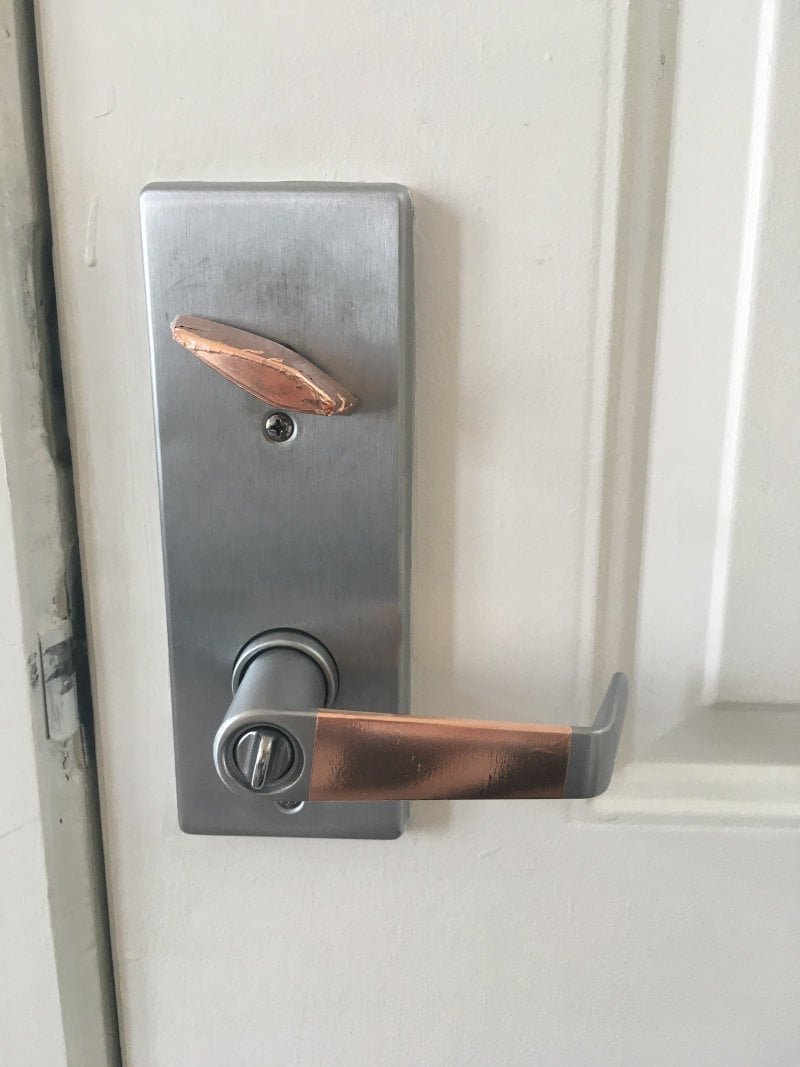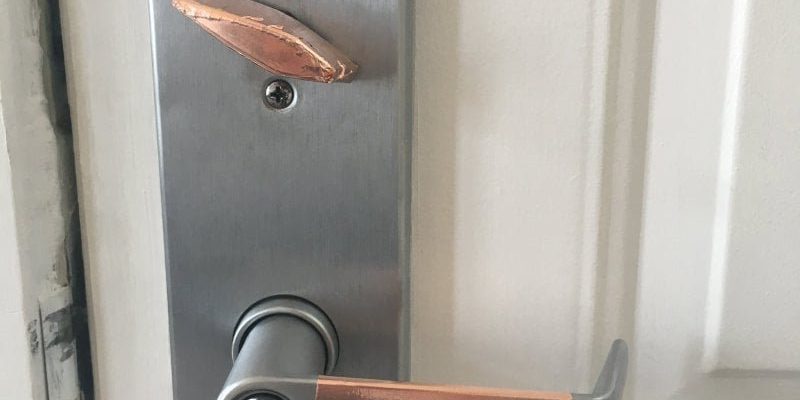
Here’s the thing: even high-quality brands like Schlage, Kwikset, or Emtek can run into galvanic corrosion. It doesn’t matter if your door handle came as part of a matching set or if you pieced it together yourself. The real trouble starts when different metals meet up, moisture joins the party, and the whole system starts short-circuiting on a chemical level. If you’ve ever wondered why your beautiful stainless steel lever starts looking shabby next to a brass lock—or why your matte black deadbolt flakes while the rest of your hardware stays clean—galvanic corrosion is usually the culprit.
What Exactly Is Galvanic Corrosion?
Let me explain. Galvanic corrosion is a type of electrochemical reaction that happens when two different metals touch each other while also touching something wet or conductive, like rain or salty air. Think of it like a battery that you didn’t mean to build—your hardware is quietly passing electrical current between two metals, and over time, one ends up getting eaten away.
This is different from regular rust. With ordinary rust, you need iron, oxygen, and water. But galvanic corrosion can happen with all kinds of metals—steel, brass, aluminum, zinc, and more. The real trick is that there have to be two *different* metals touching, and some sort of moisture connecting them. The more “unlike” the metals are, chemically speaking, the stronger the reaction.
So if you have a brass doorknob screwed onto a painted steel plate, or an aluminum mailbox bolted to a stainless steel frame, you’ve set up the conditions for galvanic corrosion. Even a small amount of rain or humidity can kick things off. Over weeks or months, one metal (the “anode”) will slowly lose atoms to the other (the “cathode”), causing everything from chalky residue to deep pitting.
Why Is Galvanic Corrosion Such a Problem for Exterior Door Hardware?
Honestly, exterior door hardware is one of the most vulnerable spots on your whole house. Unlike kitchen appliances or interior fixtures, door handles and locks face every kind of weather—rain, snow, salty breezes, or even just morning dew. All that moisture is exactly what galvanic corrosion needs to get started.
Even top brands can’t always prevent this if their products mix different metals. Manufacturers like Schlage or Kwikset try to coat their hardware with protective finishes, but those coatings can wear thin or get scratched. Once the raw metal is exposed, any tiny screw, backplate, or latch made from a different metal can trigger the problem.
Here’s an example: Imagine you install a fancy oil-rubbed bronze handle on your front door, but the screws are plain steel. Every time it rains, water seeps in—maybe just a drop or two. Over months, you’ll see the steel screws start corroding, while the handle itself might change color or get strange bumps where the metals meet. It’s not a defect in the hardware; it’s just simple chemistry at work.
How Different Metals “Fight” Each Other: The Galvanic Series
You might be wondering, “Why do some metals get destroyed, while others stay shiny?” That’s where the galvanic series comes in—a kind of ranking that sorts metals by how likely they are to give up electrons when paired with another metal.
In simple terms:
- Metals like zinc or aluminum are more “active” and corrode faster (they’re anodic).
- Metals like stainless steel or brass are less “active” and usually stay protected (they’re cathodic).
When two metals are connected, the more *anodic* one will always get sacrificially eaten away. So, if you bolt zinc screws into a brass handle, the zinc will corrode first—even if the brass stays spotless. This is why mixing hardware metals can turn into a maintenance headache. If you’re reusing old screws on new hardware, or adding a stainless deadbolt to an aluminum door, pay attention to what’s touching what.
Galvanic corrosion only needs a small bit of “unlike” metals touching each other, plus some moisture, to start the whole process.
What Does Galvanic Corrosion Look Like on Door Hardware?
The signs aren’t always obvious at first. Galvanic corrosion doesn’t always look like plain orange rust—instead, it often shows up as:
- Chalky, white, or bluish-green deposits (especially on aluminum or brass)
- Powdery gray fuzz or flaking spots
- Pitting, rough patches, or tiny holes near where two metals connect
- Discoloration or black streaks running away from screws or fasteners
You might notice your lock feels stiff, or your key sticks because of crusty residue inside the mechanism. In coastal areas, salty air makes it even worse—corrosion can practically creep overnight.
Here’s a quick story: A neighbor of mine in Florida had a set of beautiful brushed nickel handles. Within a year, anywhere the handles met the mounting plate, greenish powder started creeping out. They thought it was mold, but it was actually galvanic corrosion between the nickel and the zinc fasteners. The finish eventually peeled off, and the handle became rough to the touch.
Why It’s Not Just “Old Age”
People often blame fading, peeling, or rough hardware on old age, but honestly, brand-new hardware can start showing symptoms within months if the metals aren’t matched properly. If you move into a new home and notice your lock is already looking crusty, check what metals are used in the hardware—this could be your answer.
How Can I Prevent Galvanic Corrosion on My Exterior Door Hardware?
Prevention comes down to two things: *keeping moisture away* and *choosing compatible metals*. Here’s how you can get ahead of the problem:
- Match metals wherever possible. If your handle is brass, use brass screws and plates. Mixing metals is what starts the reaction in the first place.
- Use protective coatings. Some brands, like Emtek, add extra-thick finishes to their hardware, but these can scratch or wear off over time.
- Seal exposed joints. Use weatherproof silicone or gaskets between different metals. This helps block water and keeps the metals from touching directly.
- Keep hardware dry. Covered entryways or regular drying after rain helps slow things down. In salty or humid climates, it’s even more important.
- Inspect hardware regularly. Catching the first signs—like powdery build-up or small pits—lets you clean and reseal the area before it gets worse.
If you need to swap hardware, check with the manufacturer’s specs. Universal door hardware kits are convenient, but sometimes they mix metals by accident. It might take a few extra minutes, but making sure fasteners and plates match the handle is worth it.
Are Universal or Brand-Name Hardware Sets Better?
You might be tempted by universal door hardware sets because they’re easy to find and often fit many doors. But universal sets sometimes include a mix of metal types—steel screws with brass plates, or aluminum latches with stainless handles. Brand-name sets (like Schlage, Kwikset, or Baldwin) usually try to match metals better, but it’s not a guarantee.
If you buy universal hardware, double-check the product labels or ask customer service about the material types for *every* part, including the hidden fasteners. It’s not just about looks—the inside parts matter for corrosion, too.
What Should I Do If I Already See Galvanic Corrosion?
Don’t panic! Most hardware can be saved if you catch it early. Here’s what you can do:
- Clean the corrosion gently. Use a soft brush or cloth and a mild solution like vinegar and water. Avoid harsh scrubbing—don’t damage the finish.
- Dry everything thoroughly. Moisture speeds up the reaction, so make sure the area is totally dry before reassembling.
- Apply a protective coating. After cleaning, use a spray-on sealer or a dab of clear nail polish on exposed spots. This helps insulate the metals from moisture.
- Replace damaged parts with matching metals. If screws or plates are too far gone, swap them for parts made from the same metal as your main hardware.
If the corrosion has caused deep pitting or the hardware feels loose, it may be time to replace the set. In some cases, galvanic corrosion can weaken the structural integrity of a lock or handle, making it unsafe.
Can I Just Paint Over the Corrosion?
Painting over corrosion *might* hide the problem for a while, but it won’t stop the chemical reaction underneath—especially if moisture can still sneak in. For a real fix, address both the metal combination and moisture exposure.
How Does Galvanic Corrosion Compare to Other Types of Corrosion?
You might wonder if it’s “just rust” or something different. Regular rust only happens with iron or steel and needs oxygen and water. Galvanic corrosion, however, can affect *any* combination of metals—brass, copper, aluminum, you name it—so long as two different metals are touching and moisture is present.
This means you can have a stainless steel plate (which usually won’t rust) turn ugly if paired with the wrong kind of screw. Sometimes, both types of corrosion can happen together, especially in humid climates. That’s why even “rust-proof” hardware can fall victim if it’s not installed carefully.
Think of galvanic corrosion as a hidden “team sport”—every connected metal part on your exterior door can contribute, for better or worse.
Tips for Choosing and Installing Door Hardware to Avoid Corrosion
If you’re upgrading your entryway or replacing worn-out hardware, here are some practical tips:
- Check material labels. Look for “all brass,” “all stainless,” or similar notes. Try to avoid mixing, even if colors or finishes look matched.
- Ask for same-metal fasteners. If you buy hardware at a store or online, request fasteners made of the same metal as your handle or lock.
- Install with care. Don’t overtighten screws, as this can scratch protective finishes and expose raw metal.
- Use weatherproof seals. A little silicone at connection points can make a big difference by blocking moisture, especially on the bottom edge of door plates.
- Choose hardware rated for your climate. Some brands offer “marine grade” or “coastal” finishes that are extra resistant to corrosion.
Don’t be afraid to ask your installer—or the store clerk—exactly what metals come in the box. It’s much easier to match up materials from the beginning than to fix corrosion later on.
Final Thoughts: Take the Science Out of Your Entryway
Exterior door hardware really does face a daily chemistry test. Galvanic corrosion isn’t a sign of bad luck or poor quality—it’s just what happens when the wrong metals meet up in the wrong environment. Matching metals, sealing out water, and choosing the right brands or coatings can keep your entryway looking sharp and working smoothly for years. If you’re starting to see those telltale white crusts or pit marks, don’t ignore them. A little prevention, some careful cleaning, and attention to detail with materials can save you a lot of hassle—and maybe even a lockout or two—in the long run.
